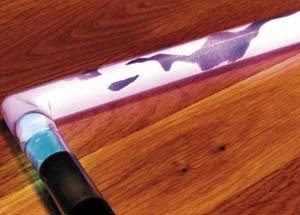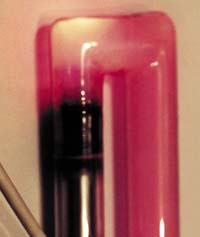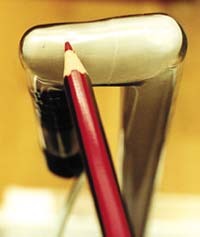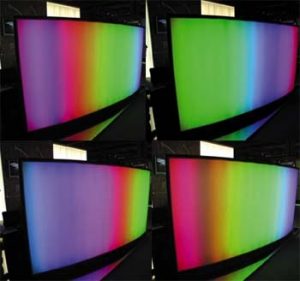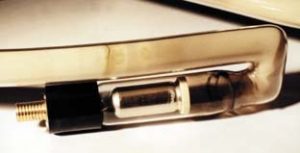LEDs + Lighting
Tube-Failure Pictures
Visible indicators for neon problems and their causes
Published
18 years agoon
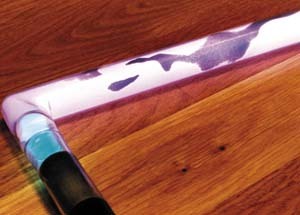
During numerous sign inspections, I’ve encountered recurring phenomena. This month, I’ll share my experiences and discuss common defect causes. As mentioned numerous times in past articles, a thorough visual inspection of a neon sign and its tubes is a serviceperson’s bread and butter.
In the long run, a half-hearted inspection and quick repair of the symptoms will further upset a client. In some cases, I recommend thoroughly examining the entire installation using sophisticated test equipment. Although expensive, this procedure is typically the most effective because it determines a problem’s roots.
Dark patches
Fig. 1 shows a common problem that’s easily identified even during the day, when the sign is off. Dark, sometimes mirror-like, irregular patches cover a tube within the first few days of a sign’s operation. The tube will still light when the sign is switched on. Before attempting any repairs, however, ensure such patches aren’t simply dirt or bird droppings.
Once the tube is removed from the sign, apply gentle heat from a lighter. Be sure to move the flame back and forth, or the glass will crack when heat is applied in one spot. If the patches start moving, the problem is caused by contaminated mercury.
Normally, mercury contracts and forms tiny droplets that roll on the fluorescent-powder layer. Any mercury contamination will reduce surface tension, causing the mercury to wet the fluorescent powder, creep in between the glass and phosphor layer, and form a metallic mirror deposit. The best remedy is to remake the tube. However, because repairing mercury tubes is hazardous, your shop should not attempt mercury repairs.
For the best results, discard your existing mercury bottle for a new one, which should be cleaned with new mercury-dispensing equipment to remove the contamination source. Because such impurities as sawdust or cork fragments can also poison mercury, check the tube for cleanliness before attaching the electrode. If the problem persists with a new tube, have the tubes analyzed in a laboratory to determine the contamination’s exact source.
Ruby blues and sputtering
The dimming of neon-filled units very often prompts service calls. Mainly, this occurs in long units, where the glass isn’t coated with phosphor, especially in units made from colored (ruby) glass (see ST, March 2000, page 72). In severe cases, the tube may become very hot during operation, but not necessarily.
The best cure is to repump the tubes and bake them out much hotter by applying a better vacuum. Also, use helium bombardment to internally scrub the tube to get rid of any contaminants emerging from the glass mass. If the problem persists, you might need to have your pumping system/bombarder serviced.
Fig. 2 reveals a third typical problem — the tube is very dim except for a bright spot in the electrode shell’s line of sight. Chances are, the tube is completely dead (Fig. 2) depicts the tube’s unsteady state). If operation continues for approximately 30 minutes after the tube reveals an unsteady condition, it will become completely inoperable. The bright spot shown in the photo gets so hot that the glass will melt and air will rush in and destroy the tube (Fig. 3).
This problem is gas cleanup caused by sputtering. Note that black deposit at the electrode glass is only in front of the ceramic collar or electrode shell. The glass in the back is clear.
If the tube has been operating for more than 30,000 hours, it might have reached its life expectancy. Only in this case can you simply remake the tube. But if the sputtering occurred prematurely, you must first determine what’s causing it. Because the causes are plentiful, it’s best to first consult an expert to check all manufacturing and operating parameters. If you try to repair the tube yourself, the problem may recur in the near future.
If your three-tube set has identical geometry and length, you’ll never obtain white when all tubes are set to 100% current (presuming identical transformer controls for all three channels). Rather, you’ll merely achieve a pastel-green tint. If you want to uniformly light a box, adjust the tube so the least intense color (red) will be the longest tube, and the most intense (green), the shortest.
A rough calculation can be made with the tube suppliers’ lumens-per-ft. lengths. Match the footage of the single colors so their total lumen output is the same ratio as the primary color point from the desired white. Distributing this tube length is a different task I’ll discuss later.
If the architectural environment doesn’t permit different tube lengths for each color, the ideal white will be reached with circuits set to unequal power levels. In other words, the white balance becomes a software problem.
The position of the tubes in a cove or lightbox is critical. They shouldn’t block the light or cast shadows of other colors. Thus, clear red is often chosen over ruby-red argon because the clear-red tube is transparent for other colors, and it can be situated atop other tubes. The distance from the tubes to the scattering surface, whether it’s a wall, cove or lightbox cover, impacts the effect.
I recommend experimentation with different face materials. My rule of thumb is: The more dense the (frosted) white, the closer you can put the tubes (while keeping acceptable uniformity). But, more light is lost.
However, there’s a compromise. Acrylics showing two different surface finishes — the rough side pointing toward the tube will provide additional scattering and balance shadows in shallow boxes — often provide good results.
The electrical side
Different methods and philosophies may control two or more channels. Of course, someone could build his own controls and use a standard transformer. But, digital controls using the DMX-512 protocol, first introduced to manage stage lighting, have been widely adopted for color-mixing neon. Control units range from small, handheld consoles to expansive, PC-based, cellphone-patched command centers that accept data from various sources.
If someone uses larger circuits normally set to a similar color and intensity, high-voltage neon or cold-cathode transformers are simple to use and cost effective.
When selecting UL 2161-compliant transformers, contact the manufacturer or distributor to ensure the particular model is designed for unlimited dimming; otherwise, the protection may keep tripping at no fault. The interface between the controller and neon transformer decodes the digital signal for each channel and converts it into a dimmer setting at the addressed output for the transformers.
Thus, a change in the digital value for channel X — for instance, one assigned to the red tubes — will appear in the equivalent change of the power to the neon tube and alter the red’s brightness in fractions of a second.
If you plan to use existing, DMX-controllable dimmers for neon/cold-cathode color mixing, use heavy-duty, stage models explicitly designed for inductive (motor) loads. Others will likely turn into smoke within seconds.
Electronic transformers simplify matters. However, for installations with many animated channels that create dynamic effects, the use of separate control units, and magnetic transformers for each channel, are cost prohibitive.
Today, different electronic-component manufacturers include British manufacturer Mode Lighting’s Digitron/Colortran, or German-based Hansen Neon’s Dimmbox, which provide independent, high-voltage output for up to three channels from a single electronic box controlled by a direct computer connection. Generally, the output is limited to 990V to accommodate a low-voltage installation, which limits tube length to 8 ft. or less for a 25mm tube (shorter for smaller tube diameters).
With electronic units, protection isn’t a concern; built-in components are matched to the dimming service requirements. An Italian product slated for a November introduction offers four channels (red, green, blue and white), improved color rendering and white balance.
Color-changing and color-mixing neon — as well as other types of dynamic lighting — can influence feelings. However, in times of change, don’t let colorful lights sway you.
SPONSORED VIDEO
Introducing the Sign Industry Podcast
The Sign Industry Podcast is a platform for every sign person out there — from the old-timers who bent neon and hand-lettered boats to those venturing into new technologies — we want to get their stories out for everyone to hear. Come join us and listen to stories, learn tricks or techniques, and get insights of what’s to come. We are the world’s second oldest profession. The folks who started the world’s oldest profession needed a sign.
You may like
Advertisement
Subscribe

Magazine
Get the most important news
and business ideas from Signsofthetimes Magazine.
Advertisement
Most Popular
-

 Tip Sheet2 weeks ago
Tip Sheet2 weeks agoAlways Brand Yourself and Wear Fewer Hats — Two of April’s Sign Tips
-

 Photo Gallery4 days ago
Photo Gallery4 days ago30 Snapshots of the 2024 ISA Sign Expo
-

 Ask Signs of the Times6 days ago
Ask Signs of the Times6 days agoWhy Are Signs from Canva so Overloaded and Similar?
-

 Real Deal2 weeks ago
Real Deal2 weeks agoA Woman Sign Company Owner Confronts a Sexist Wholesaler
-

 Paula Fargo1 day ago
Paula Fargo1 day ago5 Reasons to Sell a Sign Company Plus 6 Options
-

 Benchmarks1 week ago
Benchmarks1 week ago6 Sports Venue Signs Deserving a Standing Ovation
-

 Photo Gallery1 day ago
Photo Gallery1 day ago21 Larry Albright Plasma Globes, Crackle Tubes and More
-

 Women in Signs2 weeks ago
Women in Signs2 weeks ago2024 Women in Signs: Megan Bradley

